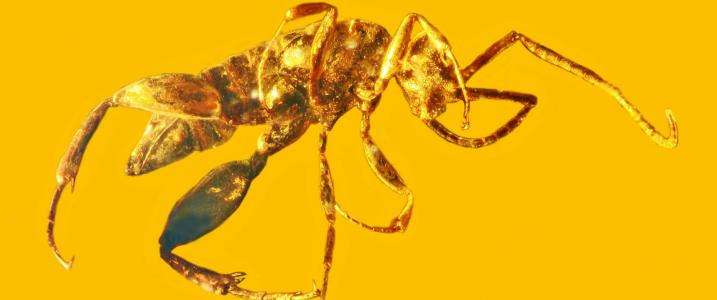Ancient wingless wasp, now extinct, is one of a kind

Researchers have identified a bizarre, parasitic wasp without wings preserved in 100-million-year-old amber, which seems to borrow parts of its anatomy from a range of other insects but actually belongs to no other family ever identified on Earth.
The specimen, which is spectacularly well preserved, probably crawled along the ground at the base of trees trying to find other insects and a place to lay its eggs. While dinosaurs strolled around above it, it looked for an insect grub of some kind it could sting.
But for reasons unknown – maybe because it couldn't fly, maybe because it died off from pathogens or habitat loss – it eventually disappeared and is now extinct.
After considerable debate, citing first one body part and then another, researchers created a new family for the specimen, called Aptenoperissidae, as part of the larger Order of Hymenoptera, which includes modern bees and wasps. Within that family, this insect, named Aptenoperissus burmanicus, is now the only known specimen.
The findings have been reported in the journal Cretaceous Research, by scientists from Russia, England and the United States.
"When I first looked at this insect I had no idea what it was," said George Poinar, Jr., a professor emeritus in the College of Science at Oregon State University, co-author on the study and one of the world's leading experts on plant and animal life forms found preserved in amber.
"You could see it's tough and robust, and could give a painful sting. We ultimately had to create a new family for it, because it just didn't fit anywhere else. And when it died out, this created an evolutionary dead end for that family."
The insect, Poinar said, brings to mind the old parable – which now has been adapted among various world religions - about six blind men being asked to touch an elephant and describe what it looked like. One who felt the tail described it as a rope; one who touched the leg said it resembled a pillar; and so on.
"We had various researchers and reviewers, with different backgrounds, looking at this fossil through their own window of experience, and many of them saw something different," Poinar said. "If you focused on its strong hind legs you could call it a grasshopper. The antenna looked like an ant, the thick abdomen more like a cockroach. But the face looked mostly like a wasp, and we finally decided it had to be some kind of Hymenoptera."
The insect is a female, and its long legs may have helped it pull out of cavities into which it had burrowed, seeking pupae of other insects into which to lay its eggs. With that lifestyle, wings would have been a hindrance, researchers noted in the study. It may have attacked other beetles with its sharp and jagged stinger, and it would have had a pretty strong leaping ability. It did have a cleaning mechanism on the tip of its antenna that is characteristic of Hymenoptera.
The fossil came from what is now the Hukawng Valley in Myanmar on the continent of Asia, where arthropods from 252 families have been found, one of the richest such deposits in all Cretaceous amber.
More information: A.P. Rasnitsyn et al. Bizzare wingless parasitic wasp from mid-Cretaceous Burmese amber (Hymenoptera, Ceraphronoidea, Aptenoperissidae fam. nov.), Cretaceous Research (2017). DOI: 10.1016/j.cretres.2016.09.003
Journal information: Cretaceous Research
Provided by Oregon State University




















